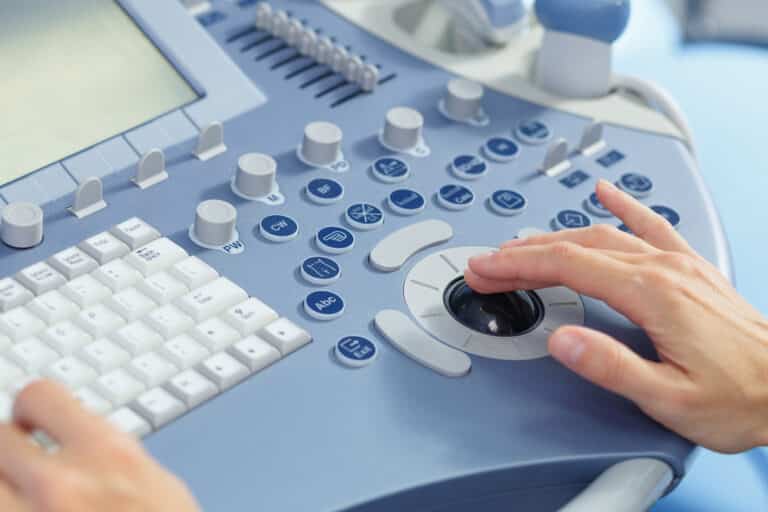Breast cancer is one of the most common cancers affecting women worldwide, and early detection is key to improving patient outcomes. As an experienced radiologist in West London, I have seen the value of breast ultrasound in detecting and managing breast abnormalities. This article aims to clarify the differences between screening and diagnostic breast ultrasounds, helping readers better understand their purposes, techniques, and benefits.
Breast ultrasound is a non-invasive, radiation-free imaging technique that uses high-frequency sound waves to create detailed images of the breast tissue. It is commonly used in conjunction with other imaging modalities, such as mammography, to provide a comprehensive evaluation of breast health. The primary purpose of breast ultrasound is to detect and further characterize breast abnormalities, including both benign and malignant lesions.
Advantages and Limitations of Breast Ultrasound
Breast ultrasound offers several advantages over other imaging modalities. It is safe, painless, and does not expose patients to ionizing radiation. Additionally, ultrasound is particularly useful in evaluating dense breast tissue, which can be challenging to assess with mammography alone.
However, breast ultrasound has some limitations. Its accuracy and effectiveness are highly dependent on the skill and experience of the operator. Additionally, ultrasound can produce false-positive results, leading to unnecessary biopsies or follow-up tests, as well as false-negative results, which may delay the diagnosis of a malignant lesion.
Role in Breast Cancer Detection and Management
Breast ultrasound plays a crucial role in the early detection and management of breast cancer. It can be used as a supplementary screening tool for women at increased risk of breast cancer or those with dense breast tissue. In cases where an abnormality is detected through other imaging methods or physical examination, ultrasound can provide additional information to help determine whether the abnormality is benign or malignant. Furthermore, breast ultrasound is often employed to guide biopsy or drainage procedures, ensuring accurate targeting of suspicious lesions for further analysis.
Screening Breast Ultrasound
Purpose of Screening Ultrasound
Screening breast ultrasound is a population-based approach aimed at identifying women at average or high risk for breast cancer before symptoms are evident. It is typically used as a supplementary tool alongside mammography to increase the chances of early detection, particularly in women with dense breast tissue, which can obscure abnormalities on a mammogram.
Procedure and Techniques
During a screening breast ultrasound, the entire breast tissue is scanned using a handheld or automated transducer. The automated breast ultrasound (ABUS) system can provide a more standardized and efficient examination, reducing operator dependence and improving image quality.
Benefits and Limitations
Screening breast ultrasound offers the benefit of early detection, potentially identifying breast cancer at a stage where treatment options are more effective and less invasive. It can also provide additional information in cases where mammography is less sensitive, such as in women with dense breasts.
However, there are limitations to screening breast ultrasound. It may produce false-positive results, causing anxiety and potentially leading to unnecessary follow-up tests or biopsies. False-negative results can also occur, which may delay diagnosis and treatment.
Recommendations and Guidelines
Guidelines for screening breast ultrasound may vary depending on the patient’s age, risk factors, and breast density. It is essential to consult with healthcare professionals to determine the most appropriate screening strategy for each individual.
Diagnostic Breast Ultrasound
Purpose of Diagnostic Ultrasound
Diagnostic breast ultrasound is a targeted examination that focuses on further evaluating breast abnormalities detected through mammography, physical examination, or screening ultrasound. It can also be used to assess breast implants, monitor the progression of known breast conditions, and guide biopsy or drainage procedures.
Procedure and Techniques
During a diagnostic breast ultrasound, a handheld transducer is used to focus on specific areas of concern within the breast tissue. The radiologist can dynamically adjust the transducer to obtain the best possible images and further characterize the abnormality.
Indications for Diagnostic Ultrasound
Diagnostic breast ultrasound is typically performed when there is a specific indication, such as abnormal mammogram findings, palpable lumps or breast changes, evaluation of breast implants, or to guide biopsy or drainage procedures.
Benefits and Limitations
Diagnostic breast ultrasound offers improved diagnostic accuracy compared to screening ultrasound, allowing for better characterization of breast abnormalities. It is minimally invasive and does not expose patients to radiation.
However, as with screening ultrasound, the accuracy of diagnostic breast ultrasound is highly operator-dependent, which can affect the quality of the images and the resulting diagnosis.
Choosing the Right Ultrasound for Your Needs
Factors to Consider
When deciding between screening and diagnostic breast ultrasound, it is essential to consider factors such as age, risk factors, personal and family history, and breast density. Discussing these factors with healthcare professionals will help determine the most appropriate course of action.
Conclusion
Understanding the differences between screening and diagnostic breast ultrasounds is crucial for patients and healthcare providers alike. Both techniques play important roles in early detection and management of breast abnormalities, including breast cancer. Regular check-ups and maintaining open communication with healthcare professionals are vital for optimal breast health and ensuring the most appropriate imaging strategy is employed.










